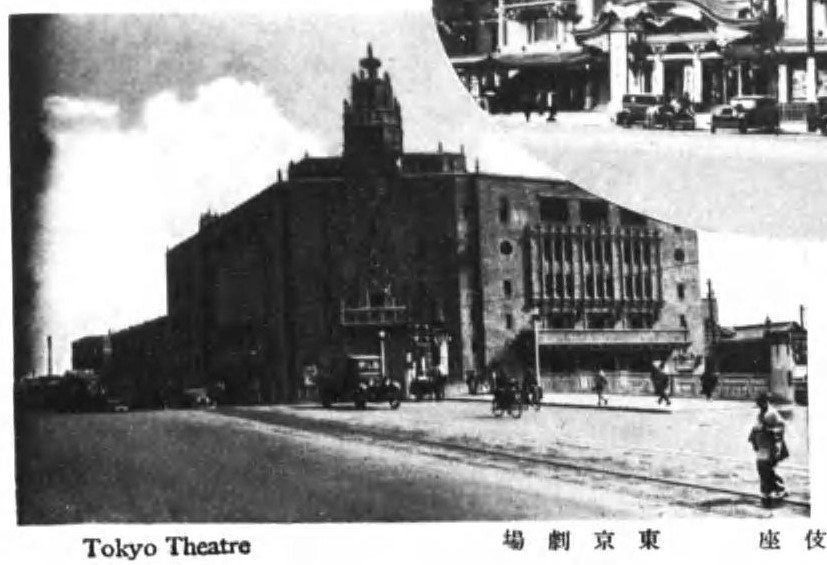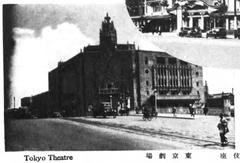
Tokyo Gekijo Visiting Hours, Tickets, and Historical Sites Guide
Date: 15/06/2025
Introduction: Tokyo Gekijo and Tokyo’s Theatrical Legacy
Tokyo Gekijo—often called Tokyo Theatre or Togeki—stands as a pivotal institution in Tokyo’s performing arts scene. Established in 1930 in the bustling Tsukiji district, it is renowned for its innovative architecture, role in preserving Kabuki during turbulent times, and evolving embrace of both traditional and modern entertainment. From its iconic revolving stage and hanamichi runway to its strategic location near other cultural landmarks, Tokyo Gekijo is a must-visit for anyone seeking to experience the depth and dynamism of Japanese theater (Old Tokyo).
Remarkably, Tokyo Gekijo survived the 1945 World War II firebombing raids—the only major Kabuki theater in Tokyo to do so—enabling it to lead the postwar revival of Japanese performing arts (Kabuki21). Over the decades, the venue evolved from a Kabuki stronghold to a modern entertainment complex, reflecting Tokyo’s ever-changing cultural landscape.
Complementing Tokyo Gekijo, the Imperial Theater and Tokyo Metropolitan Theatre stand as pillars of the city’s theatrical tradition. The Imperial Theater, dating back to 1911, is Japan’s first Western-style theater, while the Tokyo Metropolitan Theatre, opened in 1990, is a beacon of contemporary culture and performance (artandlive.net; Tokyo Metropolitan Theatre Official Website).
This comprehensive guide explores the history, visitor logistics, performance schedules, accessibility, and nearby attractions of these celebrated venues—equipping you to fully appreciate Tokyo’s performing arts heritage.
Table of Contents
- Historical Overview of Tokyo Gekijo
- Visitor Information for Tokyo Gekijo
- Discover Tokyo Gekijo: Ultimate Visiting Guide
- Visiting the Imperial Theater
- Visiting Tokyo Metropolitan Theatre
- Summary: Key Points
- Sources and Official Links
Historical Overview of Tokyo Gekijo
Foundations and Growth
Tokyo Gekijo opened in 1930 as a state-of-the-art venue in Tsukiji, boasting nearly 1,900 seats and cutting-edge design, including a revolving stage and hanamichi runway—crucial for authentic Kabuki (Old Tokyo). Its diverse programming encompassed traditional Kabuki, Western opera, and film, and its location—just blocks from the famed Kabuki-za—placed it at the heart of Tokyo’s theater district.
Wartime Resilience and Postwar Revival
During WWII, Tokyo Gekijo withstood the devastating 1945 firebombing raids, making it the only major Kabuki theater to survive intact (Kabuki21). Shortly after Japan’s surrender, it hosted a landmark Kabuki performance, symbolizing resilience and cultural recovery. Through the late 1940s, the theater anchored Tokyo’s Kabuki scene, staging major events and ceremonies critical to the preservation of Japanese performing arts.
Transformation and Modernization
As the Kabuki-za reopened in 1952, Tokyo Gekijo transitioned into a “Road Show Theater,” focusing on film screenings (Old Tokyo). In 1975, it was modernized and rebranded as “Tōgeki,” maintaining its cultural relevance and adapting to the entertainment needs of contemporary audiences (Kabuki21).
Architectural and Cultural Highlights
The theater’s design bridges tradition and modernity, featuring a revolving stage and hanamichi for Kabuki, and advanced technical facilities for concerts and film. Its proximity to Tsukiji Market and Kabuki-za creates a unique cultural corridor within the city.
Lasting Influence
Today, Tokyo Gekijo is celebrated for its adaptability and enduring contribution to Tokyo’s performing arts heritage, symbolizing both preservation and innovation (Kabuki21; Old Tokyo).
Visitor Information for Tokyo Gekijo
Visiting Hours
- Opening Times: Typically, doors open one hour prior to showtime; closing follows soon after the performance.
- Recommendation: Always confirm the current schedule via the official website or box office.
Ticketing
- Purchasing Options: Online (official and third-party platforms), box office, or by phone.
- Prices: Vary based on performance and seating category; advance booking is highly recommended for popular events.
Accessibility
- Facilities: Wheelchair access, reserved seating, and additional assistance upon request. Contact the theater in advance for special accommodations.
Getting There
- By Subway: Tsukiji Station (Tokyo Metro Hibiya Line) and Higashi-Ginza Station (Toei Asakusa & Hibiya Lines) are closest. Both stations are a short walk from the theater.
- Other Options: Taxi and bus services are also available.
Nearby Attractions
- Tsukiji Outer Market: Famous for seafood and traditional foods.
- Kabuki-za Theater: Two blocks away, offering additional Kabuki performances.
- Ginza District: Upscale shopping and dining.
- Tokyo International Forum: Event space and architectural landmark.
Special Events & Tours
- Occasional guided tours, educational programs, and special exhibitions. Inquire in advance about availability and photography policies.
Discover Tokyo Gekijo: Ultimate Visiting Guide
Location & Access
Situated in the Hibiya district of Chiyoda Ward, Tokyo Gekijo is within walking distance of Hibiya and Yurakucho stations—well-connected by Tokyo Metro and JR lines (Truly Tokyo; Arigato Japan). The area is pedestrian-friendly and signposted in both Japanese and English.
Visiting Hours
- Box Office: Generally open 10:00 AM–6:00 PM on performance days; hours may vary.
- Tip: Arrive at least 30 minutes early for ticket collection and to explore exhibitions.
Theatre Layout & Facilities
- Capacity: 1,800+ seats with excellent acoustics.
- Amenities: Spacious lobbies, accessible restrooms, elevators, cloakrooms, and concessions. The lobby often features costume or set exhibitions.
Ticketing: Pricing & Reservations
- Range: ¥4,000–¥15,000, depending on seat and production (Japlanease).
- Third-Party Services: Klook and KKday provide services for international visitors.
- Guided Tours: Occasionally available; check official site for details.
Performance Schedule & Genres
- Kabuki: Traditional theater with English support often available.
- Musicals/Plays: Japanese and international titles.
- Concerts/Dance: From classical to contemporary.
- Special Events: Seasonal and guest artist performances. Schedules are posted months in advance.
Language & Accessibility
- English Support: Booklets, subtitles, and audio guides for many shows; confirm when booking (The Art of Gallivanting).
- Accessibility: Full wheelchair access, assistive devices, and guide dog allowance.
Etiquette & Dress Code
- Attire: Smart casual recommended.
- Conduct: Punctuality is essential; no photography/recording in the auditorium; applause at scene/act ends.
Dining & Nearby Attractions
- Dining: From casual izakayas to fine kaiseki restaurants (reservations advised).
- Culture: Hibiya Park, Imperial Palace East Gardens, and Ginza are nearby (Arigato Japan).
Practical Tips
- Coin Lockers: Available at nearby stations (Two Wandering Soles).
- Transport: Use IC cards like Suica/Pasmo (Truly Tokyo).
- Connectivity: Rent pocket Wi-Fi or SIM cards.
- Seasonality: Book early during peak times (Golden Week, New Year).
Visiting the Imperial Theater
Overview
The Imperial Theater, established in 1911, is Japan’s oldest Western-style theater and a symbol of the nation’s Meiji-era modernization (artandlive.net; mlit.go.jp). Its original Renaissance design, inspired by European opera houses, set a new standard for Japanese performing arts venues.
Visitor Information
- Hours: 10:00 AM–6:00 PM on non-performance days (for tours/museum visits); performance times vary.
- Tickets: Available online and at the box office; advance booking is essential for major shows.
- Accessibility: Full wheelchair access, elevators, and dedicated seating.
- Guided Tours: Offered periodically—check the official schedule.
Features & Experience
- Architecture: Opulent interiors, stained glass, and advanced stage technology.
- Art Museum: Ninth-floor gallery with rotating exhibitions.
- Dining/Lounges: Enhance the visitor experience.
Nearby Attractions
- Location: Marunouchi district, facing the Imperial Palace.
- Points of Interest: Imperial Palace Gardens, Hibiya Park, Ginza shopping.
Visiting Tokyo Metropolitan Theatre
History & Significance
Opened in 1990 in Ikebukuro, Tokyo Metropolitan Theatre is renowned for its acoustics, grand organ (9,000+ pipes), and diverse programming, including classical concerts, theater, opera, ballet, and festivals (Tokyo Metropolitan Theatre Official Website).
Access
- Nearest Station: Ikebukuro (West Exit), served by JR, Tokyo Metro, and private lines.
- Navigation: Bilingual signage; easy walking route from station.
Visiting Hours & Ticketing
- Box Office: 10:00 AM–7:00 PM; hours may change with performance schedule.
- Purchase: Online (with English support for some events), box office, or third-party vendors.
Performance Lineup
- Classical concerts, plays, opera, ballet, and cultural festivals.
- English-language support available for select international events.
Facilities
- Wheelchair-accessible seating, elevators, accessible restrooms.
- On-site café/restaurant, cloakroom, and free Wi-Fi.
- Coin lockers for large luggage are available at Ikebukuro Station.
Visitor Tips
- Arrive 30 minutes early for ticket collection and security.
- Smart casual attire; semi-formal for gala events.
- No photography/recording in performance halls.
Nearby Attractions
- Sunshine City: Shopping and entertainment complex.
- Anime/manga stores: Specialty shops and themed cafés in Ikebukuro.
Summary: Key Points
Tokyo Gekijo is an enduring symbol of Tokyo’s performing arts resilience and innovation. From its 1930 inception through postwar recovery and modernization, it has continually adapted to changing times while preserving tradition (Old Tokyo; Kabuki21). Its central location near Tsukiji Market, Kabuki-za, and Ginza enhances its appeal for visitors.
The Imperial Theater and Tokyo Metropolitan Theatre further enrich Tokyo’s theatrical landscape, offering historical depth and contemporary creativity (artandlive.net; Tokyo Metropolitan Theatre Official Website). Together, these venues provide a vibrant corridor for exploring Japan’s cultural heritage.
Plan your visit by securing tickets in advance, exploring nearby attractions, and embracing Tokyo’s unique blend of tradition and innovation. For updates, performance schedules, and guided tours, download the Audiala app and follow dedicated social media channels.
Sources and Official Links
- Old Tokyo: Tokyo Gekijo Theater History
- Kabuki21: Tokyo Gekijo Details
- artandlive.net: Imperial Theater Guide
- MLIT: Imperial Theater Historical Data
- Truly Tokyo: Tokyo Gekijo Visitor Guide
- The Art of Gallivanting: Tokyo Cultural Insights
- Arigato Japan: Hibiya District Guide
- Tokyo Metropolitan Theatre Official Website






























































































































































































































